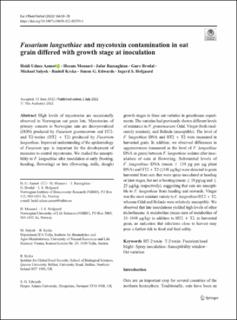| dc.contributor.author | Aamot, Heidi Udnes | |
| dc.contributor.author | Mousavi, Hesam | |
| dc.contributor.author | Razzaghian, Jafar | |
| dc.contributor.author | Brodal, Guro | |
| dc.contributor.author | Sulyok, Michael | |
| dc.contributor.author | Krska, Rudolf | |
| dc.contributor.author | Edwards, Simon G. | |
| dc.contributor.author | Hofgaard, Ingerd Skow | |
| dc.date.accessioned | 2022-10-10T14:00:52Z | |
| dc.date.available | 2022-10-10T14:00:52Z | |
| dc.date.created | 2022-07-12T12:09:44Z | |
| dc.date.issued | 2022-07-02 | |
| dc.identifier.citation | European journal of plant pathology. 2022, 164 59-78. | en_US |
| dc.identifier.issn | 0929-1873 | |
| dc.identifier.uri | https://hdl.handle.net/11250/3025172 | |
| dc.description.abstract | High levels of mycotoxins are occasionally observed in Norwegian oat grain lots. Mycotoxins of primary concern in Norwegian oats are deoxynivalenol (DON) produced by Fusarium graminearum and HT2- and T2-toxins (HT2 + T2) produced by Fusarium langsethiae. Improved understanding of the epidemiology of Fusarium spp. is important for the development of measures to control mycotoxins. We studied the susceptibility to F. langsethiae after inoculation at early (booting, heading, flowering) or late (flowering, milk, dough) growth stages in three oat varieties in greenhouse experiments. The varieties had previously shown different levels of resistance to F. graminearum: Odal, Vinger (both moderately resistant), and Belinda (susceptible). The level of F. langsethiae DNA and HT2 + T2 were measured in harvested grain. In addition, we observed differences in aggressiveness (measured as the level of F. langsethiae DNA in grain) between F. langsethiae isolates after inoculation of oats at flowering. Substantial levels of F. langsethiae DNA (mean ≥ 138 pg per μg plant DNA) and HT2 + T2 (≥348 μg/kg) were detected in grain harvested from oats that were spray-inoculated at heading or later stages, but not at booting (mean ≤ 10 pg/μg and ≤ 25 μg/kg, respectively), suggesting that oats are susceptible to F. langsethiae from heading and onwards. Vinger was the most resistant variety to F. langsethiae/HT2 + T2, whereas Odal and Belinda were relatively susceptible. We observed that late inoculations yielded high levels of other trichothecene A metabolites (mean sum of metabolites of 35–1048 μg/kg) in addition to HT2 + T2, in harvested grain, an indication that infections close to harvest may pose a further risk to food and feed safety. | en_US |
| dc.language.iso | eng | en_US |
| dc.publisher | Springer Nature | en_US |
| dc.rights | Navngivelse 4.0 Internasjonal | * |
| dc.rights.uri | http://creativecommons.org/licenses/by/4.0/deed.no | * |
| dc.title | Fusarium langsethiae and mycotoxin contamination in oat grain differed with growth stage at inoculation | en_US |
| dc.title.alternative | Fusarium langsethiae and mycotoxin contamination in oat grain differed with growth stage at inoculation | en_US |
| dc.type | Peer reviewed | en_US |
| dc.type | Journal article | en_US |
| dc.description.version | publishedVersion | en_US |
| dc.rights.holder | © 2022 The Authors | en_US |
| dc.subject.nsi | VDP::Planteforedling, hagebruk, plantevern, plantepatologi: 911 | en_US |
| dc.subject.nsi | VDP::Plant breeding, horticulture, plant protection, plant pathology: 911 | en_US |
| dc.source.pagenumber | 59-78 | en_US |
| dc.source.volume | 164 | en_US |
| dc.source.journal | European journal of plant pathology | en_US |
| dc.identifier.doi | 10.1007/s10658-022-02539-1 | |
| dc.identifier.cristin | 2038069 | |
| dc.relation.project | Norges forskningsråd: 254751 | en_US |
| cristin.ispublished | true | |
| cristin.fulltext | original | |
| cristin.qualitycode | 1 | |

